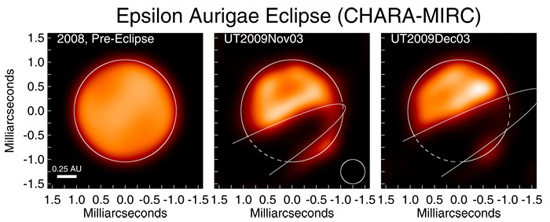Originally published April 8, 2010 at the Georgia State University website. Archived at the Internet Archive here.
By Jeremy Craig
University Relations
For the first time ever, scientists working with Georgia State University’s Center for High Angular Resolution Astronomy (CHARA) array have captured very high resolution images that shed new light on what causes the mysterious stellar eclipses of the double star system Epsilon Aurigae.
Scientists with the University of Denver, the University of Michigan and GSU used very high resolution images from the CHARA array, an array of six telescopes located atop Mount Wilson, Calif., near Los Angeles, to determine that the eclipse of Epsilon Aurigae is caused by a disk of material that resembles what the state of our solar system would have been like 4.5 billion years ago.
The results were published April 7 in Nature Letters.
“There were theories that it was a star surrounded by a thick disk that caused the eclipse, and lo and behold, that’s what we see – a disk moving like a wedge across a star,” said Hal McAlister, Regents’ Professor of astronomy and director of CHARA.
“To be able to create these images and to see what’s really going on without the prejudice of theory or models with constraints really clinches things in a way that theoretical modeling just can’t quite do,” he added.
Epsilon Aurigae, located about 2,000 light years away from Earth in the constellation Auriga, is eclipsed by its less luminous companion star every 27 years, and these eclipses have been observed since 1821. Its current eclipse, visible to the naked eye, began during late summer 2009 and will last until late 2010.
The disc, comprised of dust containing carbon compounds, is as wide as Jupiter’s orbit and is almost as tall as the orbit of the earth, but contains a little less than the mass of the Earth itself. Future research calls for understanding how the disk was formed.
To produce the images at the CHARA array, individual beams of light from the array’s six telescopes are brought together to synthesize a giant telescope hundreds of meters across through a process called interferometry. (Story continues below graphic)

“There’s no other astronomical instrument on Earth that could have done this other than the CHARA array,” McAlister said.
The array has produced several astronomical firsts, including images of the star Altair – the first detailed image of a hydrogen-burning star other than our sun. Other firsts include the direct detection of gravity darkening on a single star, Regulus; the first model-independent measurement of the diameter of a planet outside our solar system; and the first direct image of an interacting binary star system, Beta Lyrae.
More observations of the eclipse still need to be made, and scientists hope to obtain more images from the array to view the entire disk through the current eclipse to see how the disk moves away.
Some research was delayed by the massive August 2009 Station wildfire that shut down roads to the mountain and imperiled the CHARA array – with the flames coming a little less than three football fields away. The rainy season later brought mudslides which destroyed sections of the roadway leading to the observatory, but astronomers were able to make observations starting in October after the fire.
The research is supported by the National Science Foundation and through funding by the university partners.
The journal article, “Infrared images of the transiting disk in the Epsilon Aurigae system,” is available at www.nature.com/nature/journal/v464/n7290/full/nature08968.html. For more about CHARA, visit http://www.chara.gsu.edu/CHARA/.
Archived to jeremyscraig.com on 12/5/2020